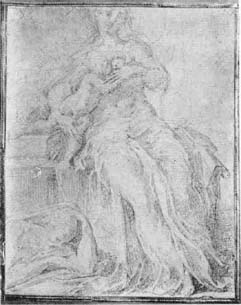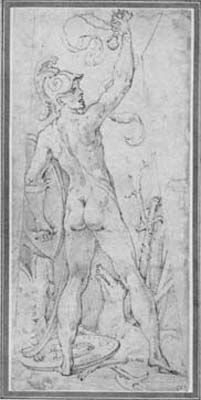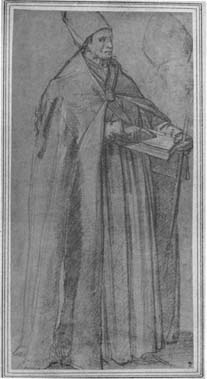
Bulletin 4 (II:2) 1964
Home
Français
Introduction
History
Annual Index
Author &
Subject
Credits
Contact



Two
Drawings by Parmigianino
by A. E. Popham
Pages 1 | 2
| 3
The Ottawa drawing is unique in one respect, in having an arched top, and this must imply that the shape of the panel had not yet been decided on and that it represents a definitely early stage in the production of the picture. It does not however follow that it is the earliest conception to have reached us. I think this can be claimed for the study in the Parma Gallery (16) (Fig. 8), in which the position of the Virgin, seated to the right, corresponds more or less with that of the Louvre drawings (Figs. 4 and 5) and that at Ottawa (Fig. 6), but here the Infant Christ steps off a sort of pedestal on the left to take the breast which His mother offers Him. The peculiar thing about this sketch is that here St Jerome is lying on the ground reading from a book, most unconventional behaviour on the part of any saint in the presence of the Virgin and Child. In spite of his unique posture he is immediately recognizable as the St Jerome of the other drawings by the gesture of his hand placed on his head. Indeed it is he and this gesture which clinch the connection with the Madonna dal collo lungo, which might otherwise have remained in some doubt. In this drawing too we find the genesis of the much admired right arm and hand of the Virgin: here the hand is offering the breast to the Child. In the drawing at Ottawa and the connected ones in the Louvre the hand is supporting the Child: next, the position of the Virgin is reversed and the hand and arm are now functionless, but Parmigianino realized the elegance of the gesture and turned what was in fact meaningless into something of importance to his design. The gesture has come to epitomize Parmigianino's idea of venustà and grazia.
The second of the two drawings (Fig. 9) is a carefully finished
pen and ink study of a nude warrior seen from the back. Presumably
he is intended to represent the god of war. He holds a shield in his
left and the hilt of what may be a sword or a banner aloft in his
right hand; (17) behind him on the left is a cuirass, on the ground
by his left foot a shield and a halberd; a baying hound crouches on
the ground to the right, and on the same side is a leafless
tree-stump against which Jeans a sword. There are puzzling questions
raised by this drawing: first, its shape; it is contained in a
curious irregular figure; secondly, its outlines are pricked in the
manner which is usually found in cartoons for embroidery, though its
scale and character make it almost impossible that it should have
been intended for such a purpose. Prompted by the subject, I had
thought that the design might have been made for engraving or
etching on armour, but I have it on the best authority that the
shape does not conform to any of the pieces which go to make up a
suit of armour, and pricking is not the usual method for
transferring a design onto metal. Were the drawing complete - a
portion at the top comprising the sword or banner is obviously
missing - a solution of the problem might have been easier, but as
it stands the purpose of the drawing must remain a mystery. The
finely pricked outlines, I should add, though they are of the type
usually associated with cartoons for the embroidery of vestments or
altar cloths, are also sometimes used for transferring a design to a
panel (a familiar example is Raphael's cartoon for the Knight's
Dream in the London National Gallery). The drawing is in any
case a unique example, as far as I know, of a drawing by
Parmigianino which served as a cartoon, apart from designs made for
the engraver.
There can in my opinion be no doubt whatever that Parmigianino is in
fact the author of the drawing, as I have assumed, though it bore an
extraordinary attribution to Mabuse in the Geiger collection,
through which it had passed. Before that it had belonged to the Abbé
Desneux de la Noue (died before 1657), whose series of Parmigianino
drawings was famous. Lord Arundel, it is said, had tried in vain to
acquire them from their owner. As to its exact date I cannot feel
any certainty: it links on to such drawings as the Ganymede
serving Nectar to the Gods, (18) which formerly belonged
to Lord Northampton, in the way in which the nude body is rendered
and particularly in the position of the legs. I once felt fairly
certain that this and other drawings finished in an engraver-like
style necessarily belonged to the latest phase of Parmigianino's
short life after his return to Parma, but I now think they may
belong to different periods.
Annual Index | Author & Subject | Credits | Contact
This digital collection
was produced under contract to Canada's Digital Collections program,
Industry Canada.
"Digital
Collections Program, Copyright
© National Gallery of
Canada 2001"